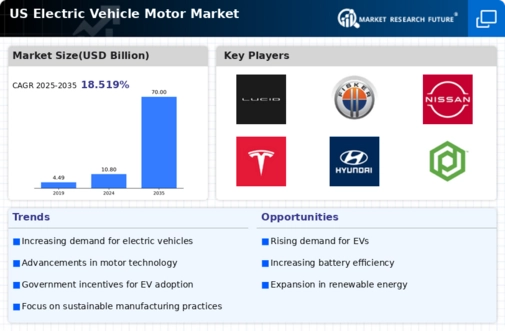Advancements in Battery Technology
Advancements in battery technology are significantly impacting the electric vehicle-motor market, as improved battery performance directly influences motor efficiency and vehicle range. In 2025, the introduction of solid-state batteries is anticipated to revolutionize the market, offering higher energy densities and faster charging times compared to traditional lithium-ion batteries. This technological leap could enhance the overall performance of electric vehicles, making them more appealing to consumers. As battery technology continues to evolve, manufacturers are likely to invest in electric motors that can fully leverage these advancements, resulting in a more efficient and powerful driving experience. The interplay between battery innovation and motor development suggests a symbiotic relationship that will drive growth in the electric vehicle-motor market, as both components are essential for the success of electric mobility.
Investment in Research and Development
Investment in research and development (R&D) plays a crucial role in the electric vehicle-motor market, as companies seek to innovate and improve motor efficiency. In 2025, R&D expenditures in the electric vehicle sector are projected to exceed $10 billion in the US, reflecting a commitment to advancing motor technologies. This investment is essential for developing lighter, more efficient motors that can enhance vehicle performance and reduce energy consumption. Furthermore, breakthroughs in materials science and engineering are likely to yield motors that are not only more powerful but also more cost-effective. As manufacturers prioritize R&D, the electric vehicle-motor market is expected to benefit from a continuous stream of innovations, which may lead to improved product offerings and increased competitiveness. This focus on R&D underscores the dynamic nature of the market and its potential for growth.
Rising Consumer Demand for Electric Vehicles
The electric vehicle-motor market experiences a notable surge in consumer demand, driven by increasing awareness of environmental issues and the desire for sustainable transportation solutions. In the US, sales of electric vehicles (EVs) have shown a remarkable growth trajectory, with a reported increase of over 50% in 2025 compared to the previous year. This heightened interest in EVs directly influences the electric vehicle-motor market, as manufacturers strive to meet the evolving preferences of consumers. The shift towards electric mobility is further supported by advancements in battery technology, which enhance vehicle range and performance. As consumers become more environmentally conscious, the demand for efficient and high-performance electric motors is likely to escalate, propelling the market forward. This trend indicates a robust future for the electric vehicle-motor market, as it aligns with broader societal shifts towards sustainability.
Collaborations and Partnerships in the Industry
Collaborations and partnerships within the electric vehicle-motor market are becoming increasingly prevalent as companies recognize the benefits of shared expertise and resources. In 2025, strategic alliances between automotive manufacturers and technology firms are expected to drive innovation and accelerate the development of advanced motor technologies. These partnerships may facilitate the integration of cutting-edge software and hardware solutions, enhancing the overall performance of electric motors. Additionally, collaborations can lead to cost-sharing in R&D efforts, enabling companies to bring new products to market more efficiently. The trend towards collaboration suggests a more interconnected industry landscape, where knowledge exchange and joint ventures could significantly impact the electric vehicle-motor market. As these partnerships evolve, they may contribute to a more robust and competitive market environment.
Increasing Focus on Sustainability and Environmental Impact
The electric vehicle-motor market is witnessing an increasing focus on sustainability and environmental impact, as both consumers and manufacturers prioritize eco-friendly practices. In 2025, a significant % of consumers in the US express a preference for products that demonstrate a commitment to sustainability. This shift in consumer behavior influences manufacturers to adopt greener production methods and materials, thereby enhancing the appeal of electric motors. Furthermore, regulatory pressures are prompting companies to minimize their carbon footprints, leading to innovations in motor design that prioritize energy efficiency. As sustainability becomes a core value in the automotive industry, the electric vehicle-motor market is likely to experience growth driven by the demand for environmentally responsible products. This trend indicates a broader societal shift towards sustainability, which could reshape the market landscape.

























Leave a Comment